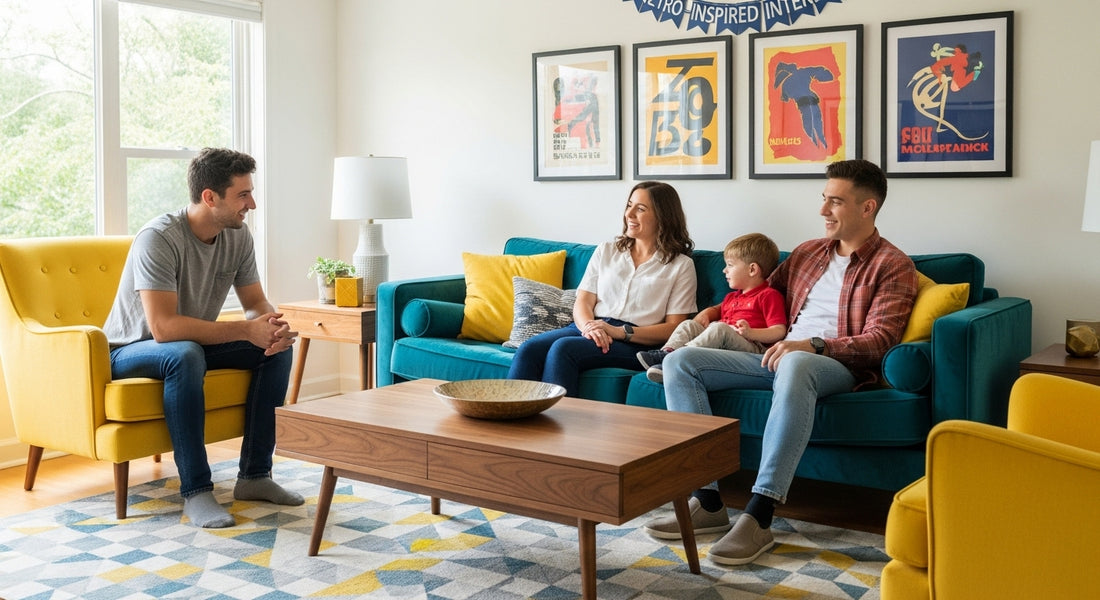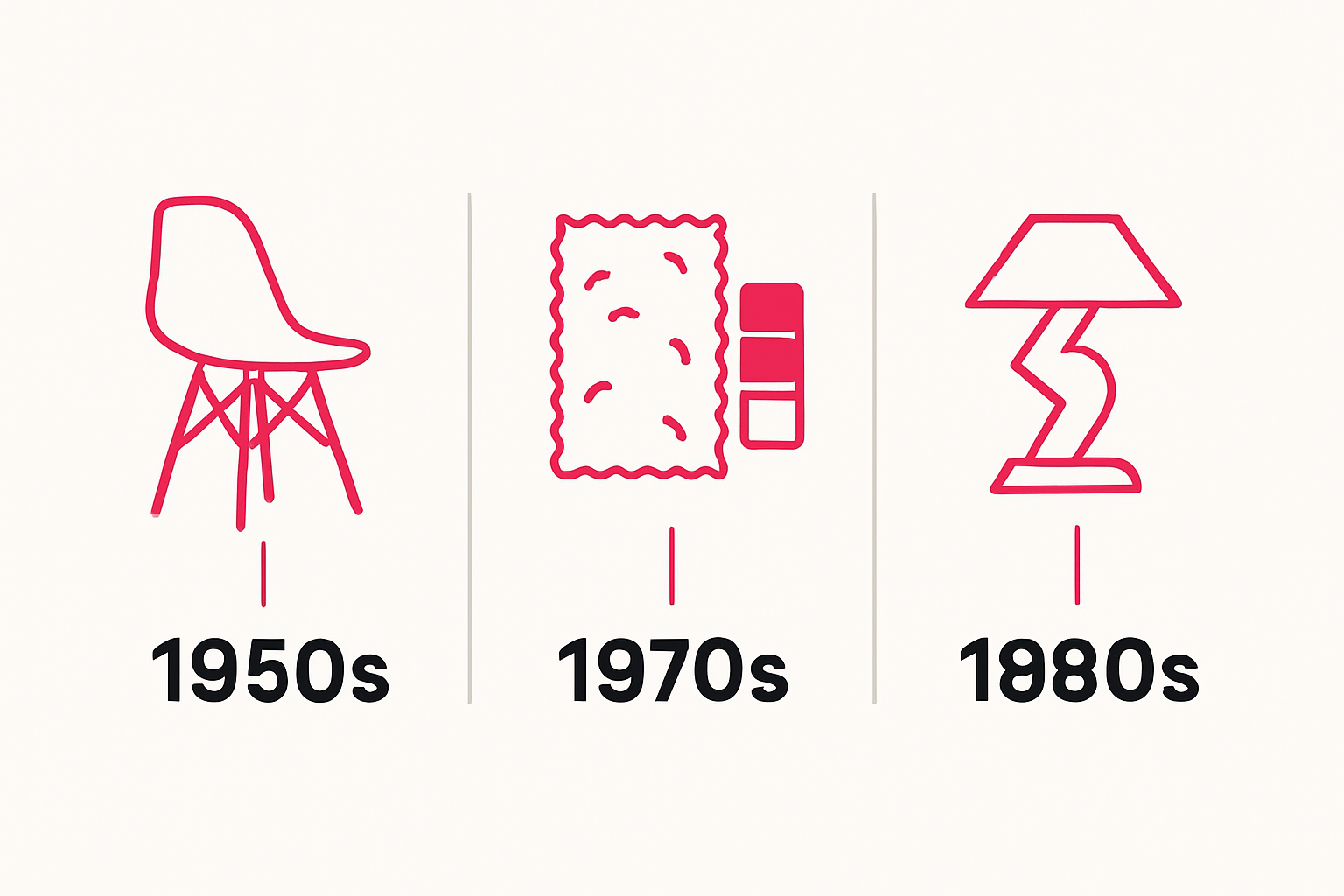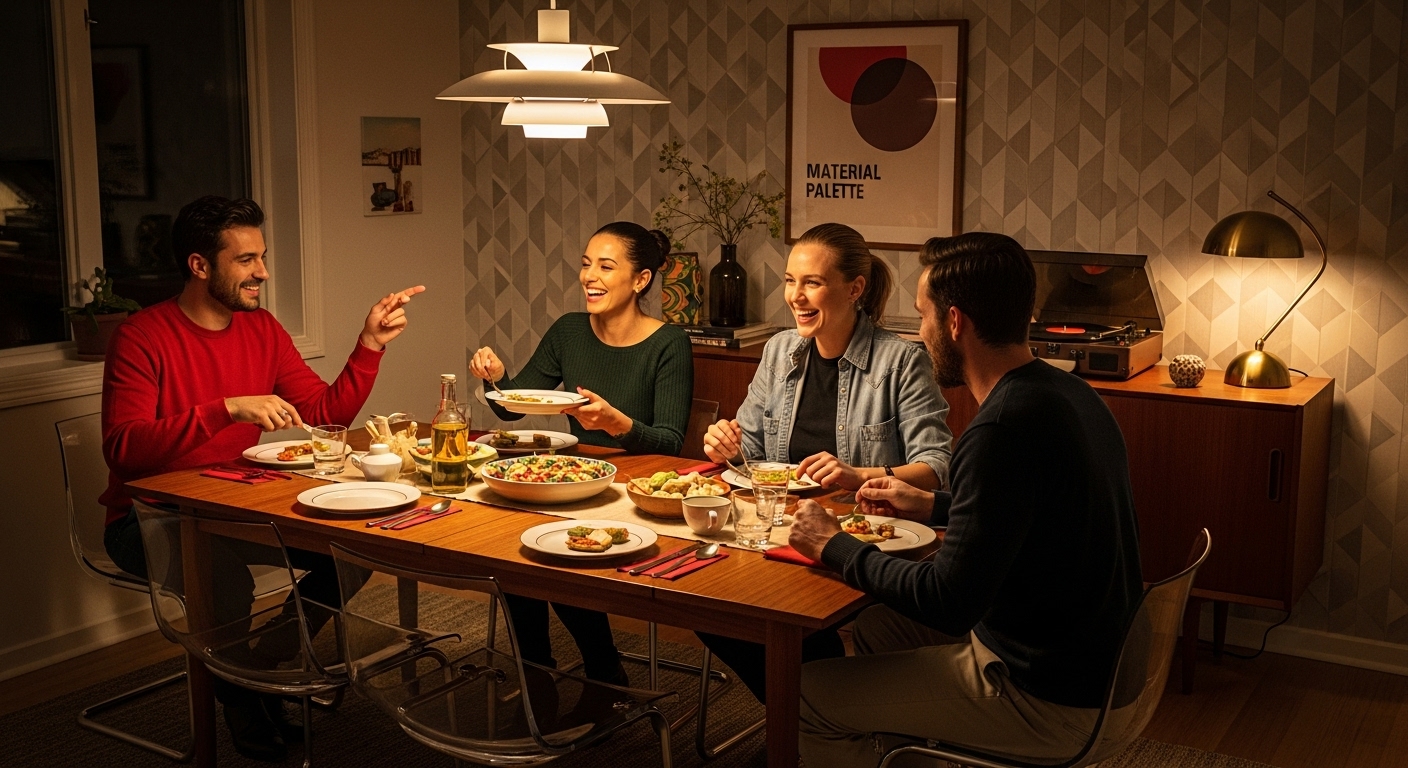
Understanding Retro-Inspired Interior Design: A Comprehensive Guide
Share
Retro-inspired interior design always turns heads with its bold patterns, bright colours and furniture that looks straight out of a 70s club. You might think this throwback style is all about kitschy nostalgia and busy wallpapers. But here’s the real surprise. Retro design actually brings modern comfort and innovation into nearly 80 percent of new South African homes experimenting with the look. That mix of old-school charm and current-day practicality makes these spaces feel familiar and totally fresh at the same time.
Table of Contents
- Defining Retro-Inspired Interior Design: Key Characteristics
- The Cultural Significance Of Retro Design Trends
- Elements And Materials Commonly Used In Retro Interiors
- Blending Retro Inspiration With Modern Aesthetics
- How Retro-Inspired Design Influences Contemporary Living Spaces
Quick Summary
| Takeaway | Explanation |
|---|---|
| Embrace vibrant colour schemes | Use unexpected colour combinations to create visual impact in retro-inspired interiors. |
| Integrate nostalgic elements thoughtfully | Blend retro pieces with modern design to maintain visual harmony and contemporarity. |
| Honor functional reimagining | Adapt vintage designs with modern materials and technology to enhance usability. |
| Create emotional connections through design | Use familiar retro aesthetics to evoke nostalgia and emotional comfort in spaces. |
| Explore the cultural narratives of design | Recognise how retro trends reflect societal changes and personal identities through decor. |
Defining Retro-Inspired Interior Design: Key Characteristics
Retro-inspired interior design represents a captivating approach to home decor that celebrates nostalgic aesthetics while integrating contemporary functionality. This design philosophy goes beyond simple replication, instead creating spaces that reimagine vintage styles through a modern lens. Explore our vintage design concepts to understand how designers blend historical charm with current sensibilities.
Aesthetic Elements and Visual Language
The core of retro-inspired interior design lies in its distinctive visual vocabulary. Key characteristics include bold geometric patterns, saturated color palettes, and furniture designs that challenge traditional expectations. According to research from ArchDaily, this design approach typically encompasses periods from the 1950s through the 1980s, each decade contributing unique stylistic signatures.

Significant visual elements include:
- Vibrant Color Schemes: Unexpected color combinations like mustard yellow with teal blue
- Geometric Patterns: Sharp angular designs and repeating mathematical motifs
- Statement Furniture: Pieces with exaggerated curves, unconventional shapes
Functional Nostalgia
Beyond aesthetic appeal, retro-inspired interior design emphasizes functional reimagining. Modern interpretations do not merely copy historical designs but reinterpret them with contemporary materials, technology, and ergonomic considerations. This approach allows spaces to feel simultaneously familiar and innovative, creating environments that honor historical design while meeting current lifestyle requirements.
The true magic of retro-inspired design emerges in its ability to evoke emotional connections. By integrating recognizable design elements from past decades, these interiors trigger nostalgia while simultaneously feeling fresh and contemporary. Each carefully curated space becomes a narrative that bridges personal memories with current design sensibilities.
The Cultural Significance of Retro Design Trends
Retro design trends represent more than aesthetic choices they embody complex cultural narratives that reflect societal transformations and collective memory. Discover why retro style is trending in contemporary culture and explore how these design movements transcend mere visual preferences.
Psychological Connections and Nostalgic Resonance
At the heart of retro design lies a profound psychological mechanism of nostalgia. According to cultural studies research, nostalgic design serves as a powerful emotional conduit, allowing individuals to reconnect with perceived simpler or more meaningful periods of historical experience. This phenomenon goes beyond romanticization it represents a sophisticated mechanism of cultural processing and emotional regulation.
Psychological dimensions of retro design include:
- Emotional Comfort: Providing psychological safety through familiar aesthetic frameworks
- Identity Exploration: Enabling individuals to construct and negotiate personal and collective identities
- Temporal Reimagining: Creating spaces that blend past and present experiences
Socioeconomic and Technological Reflections
Retro design trends function as intricate cultural commentaries on technological progression and socioeconomic shifts. Each design period encapsulates specific technological capabilities, economic conditions, and social aspirations. By revisiting and reinterpreting these design languages, contemporary creators critically engage with historical narratives, challenging linear assumptions of progress.
Moreover, retro design serves as a nuanced form of cultural critique. It allows societies to simultaneously celebrate technological advancement and acknowledge the aesthetic and emotional richness of previous eras. Through careful reinterpretation, designers transform nostalgic elements into contemporary statements about identity, innovation, and collective memory.
Elements and Materials Commonly Used in Retro Interiors
Retro interior design celebrates unique material combinations that capture the essence of mid-20th century aesthetic innovation. Read our vintage style decoration guide to understand how these materials create authentic retro environments that balance nostalgia with contemporary sensibilities.
Signature Material Palette
According to Encyclopaedia Britannica, retro interiors represent a fascinating blend of mass-produced and organic materials that reflect technological advancements and design philosophies of their respective eras. The material selection typically encompasses synthetic and natural elements that challenge traditional design boundaries.
Key materials characterizing retro interior design include:
- Molded Plastics: Fiberglass chairs, acrylic furniture with bold geometric shapes
- Wood Finishes: Teak, walnut, and rosewood with distinctive grain patterns
- Metallic Accents: Chrome, brass, and aluminum creating sleek industrial touches
Textural and Color Dynamics
Retro materials are distinguished not just by their composition but by their extraordinary textural qualities and color interactions. Designers leveraged innovative manufacturing techniques to create surfaces that were simultaneously functional and visually provocative. Vinyl upholstery, textured wallpapers, and laminate surfaces became canvases for expressing bold design statements.
The materiality of retro interiors goes beyond mere aesthetic choices. Each selected material represents a narrative of technological progress, cultural aspirations, and design philosophy.
Below is a summarising table that outlines the signature materials commonly used in retro-inspired interiors, their characteristics, and the narrative context they bring to a space.
| Material Type | Example Finishes | Unique Characteristics | Design Narrative |
|---|---|---|---|
| Molded Plastics | Fiberglass, acrylic | Bold geometric shapes, lightweight | Reflects mid-century mass production and innovation |
| Wood Finishes | Teak, walnut, rosewood | Distinctive grains, warm tones | Evokes organic modernism & natural textures |
| Metallic Accents | Chrome, brass, aluminium | Sleek, shiny, industrial touches | Symbolises technological progress |
| Vinyl Upholstery | N/A | Textured, colourful, durable | Conveys playfulness and durability |
| Laminate Surfaces | Bold print laminates | Smooth, patterned, easy to clean | Represents practicality and design experimentation |
| By integrating these carefully chosen elements, interior spaces become immersive environments that tell stories of innovation, creativity, and the dynamic relationship between human imagination and material potential. |

Blending Retro Inspiration with Modern Aesthetics
Modern interior design embraces retro elements as sophisticated dialogue between past and present, creating spaces that transcend temporal boundaries. Explore retro design trends for 2025 and discover how contemporary creators reimagine vintage aesthetics through innovative perspectives.
Strategic Design Integration
Blending retro inspiration with modern aesthetics requires nuanced understanding of design principles. According to contemporary design research, successful integration involves carefully selecting vintage elements that complement rather than compete with contemporary design languages.
Key strategies for harmonious integration include:
- Selective Reinterpretation: Choosing iconic design elements and updating them with contemporary materials
- Balanced Proportions: Maintaining visual equilibrium between vintage and modern design components
- Contextual Relevance: Ensuring selected retro elements resonate with current lifestyle and functional requirements
Technological and Aesthetic Synergy
The convergence of retro inspiration and modern aesthetics represents more than visual experimentation. It embodies a profound exploration of technological progression and cultural memory. By thoughtfully incorporating vintage design elements into contemporary spaces, designers create environments that celebrate innovation while honoring historical design achievements.
This approach transforms interior spaces into dynamic narratives that challenge linear perceptions of design evolution. Each carefully curated element becomes a testament to the ongoing dialogue between technological advancement and aesthetic imagination, inviting inhabitants to experience design as a continuous, interconnected journey.
How Retro-Inspired Design Influences Contemporary Living Spaces
Retro-inspired design emerges as a powerful transformative force in contemporary interior architecture, reshaping living environments through nuanced aesthetic and functional interventions. Creative photography techniques reveal the intricate ways vintage elements reimagine modern spatial experiences.
Psychological and Emotional Resonance
According to research from Houzz, retro design transcends visual aesthetics by creating profound emotional connections within living spaces. These design approaches tap into collective memory, transforming rooms into narratives that bridge generational experiences and personal histories.
Key psychological impacts include:
The following table compares key psychological and emotional impacts of retro-inspired design in contemporary living spaces, helping to clarify how these elements shape personal experiences in the home.
| Psychological Impact | Description | Example in Retro Design |
|---|---|---|
| Emotional Comfort | Creates a sense of familiarity, safety and warmth | Recognisable patterns/materials |
| Identity Expression | Enables personal and collective storytelling through design | Choice of vintage furniture |
| Sensory Engagement | Stimulates visual and tactile memories for immersive experiences | Use of textured wallpaper or vinyl |
| Temporal Reimagining | Blends past and present to create multidimensional environments | Retro colours with smart home tech |
- Emotional Comfort: Generating feelings of familiarity and security through recognizable design elements
- Identity Expression: Allowing inhabitants to communicate personal stories through carefully curated vintage aesthetics
- Sensory Engagement: Creating multidimensional experiences that stimulate visual and tactile memories
Functional Transformation of Living Environments
Retro-inspired design does not merely decorate spaces it fundamentally reimagines how contemporary living environments function. By integrating vintage design principles with modern technological capabilities, designers create adaptive spaces that celebrate both innovation and historical design intelligence.
Through strategic reinterpretation, retro design challenges linear perceptions of progress. Each carefully selected element becomes a conversation between past technological achievements and current lifestyle requirements. The result is a dynamic living environment that feels simultaneously timeless and innovative, inviting inhabitants to experience design as an ongoing, interconnected narrative of human creativity.
Give Your Space Authentic Retro Flair With Modern Comfort
If you love the inviting nostalgia and unique boldness described in our comprehensive guide to retro-inspired interior design, you may find it challenging to bring those visuals to life. Many people wish their homes or workspaces could feel as vibrant and personal as the trends from the 50s to 80s, yet struggle to match the right décor or rethink their tech setup so it feels both genuine and practical. Retro-inspired design isn’t just about the look, though. It’s about creating spaces that feel emotionally connected and technically advanced.
Why not blend your newfound insight with real solutions? OnlyRetro offers a handpicked selection of retro-themed tech products and accessories that let you enrich any interior with patterns, colours, and materials straight out of the golden era of design, all equipped for today’s life. Our products were curated for people who want every detail to reflect both personal passion and functional living. Take the next step and visit OnlyRetro’s main shop to transform your décor dreams into reality today.
Frequently Asked Questions
What is retro-inspired interior design?
Retro-inspired interior design is a style that celebrates nostalgic aesthetics from past decades, particularly between the 1950s and 1980s, while integrating modern functionality and materials. It involves reimagining vintage styles to create contemporary living spaces that evoke familiarity and emotional connections.
What are the key characteristics of retro interior design?
Key characteristics include bold geometric patterns, vibrant color palettes, and unique furniture designs with exaggerated shapes. This style often features unexpected color combinations and statement pieces that challenge traditional design expectations.
How can I blend retro elements with modern design?
Blending retro elements with modern design involves selective reinterpretation of vintage items, ensuring balanced proportions between retro and contemporary components, and maintaining contextual relevance to current lifestyle needs. This creates harmonious living spaces that celebrate both past and present.
What materials are commonly used in retro-inspired interiors?
Common materials in retro-inspired interiors include molded plastics, wood finishes like teak and walnut, and metallic accents such as chrome and brass. These materials reflect the technological advancements and aesthetic philosophies of the mid-20th century, contributing to the unique textural qualities of the design.